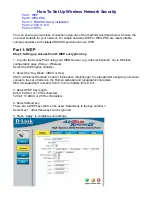
Rajant Corporation
ME BreadCrumb User Guide
- 34 -
4.3 CHANNEL ASSIGNMENTS
By default, BreadCrumb devices use channels 1 and 11 upon startup. BreadCrumb devices can be configured via
BCAdmin to choose their radio channels automatically upon startup instead. With this feature enabled,
combinations of channels 1, 8, and 11 are automatically chosen using a process designed to provide a robust
mesh.
In some cases, however, it is necessary to manually set the radios to specific channels as described
below.
4.3.1 CHANNEL ASSIGNMENT FOR SINGLE-RADIO BREADCRUMB DEVICES
Single-radio BreadCrumb devices such as the ME present a challenge for deployments in which those
BreadCrumb devices are needed to provide critical links within a mesh. For these deployments, it is imperative
that any BreadCrumb devices with which the ME is to mesh have a channel in common with the ME.
The upshot of this is that the ME and its intended peers should have their radio channels set manually in order to
ensure common channels.
As of version 9.0, single-radio BreadCrumb devices use channel 1 by default.
4.4 PHYSICAL PLACEMENT AND OTHER CONSIDERATIONS
Commonly occurring environmental factors have a significant impact on performance and behavior of the
BreadCrumb Wireless Network. LOS (Line of Sight) obstructions, distance, weather, and device placement
should all be considered when deploying a wireless network.
IEEE
802.11b wireless operation degrades gracefully as distance increases between nodes or as interference
becomes prominent. This manifests as a data rate reduction between nodes.
The goal in planning and deploying a BreadCrumb Wireless Network is to maximize both coverage and
the data transfer rate between devices. These can be maximized by taking into consideration all of the
contributing factors described in this section.
4.4.1 LINE OF SIGHT
Unobstructed LOS (Line of Sight) is critical for optimal performance of the BCWL. Partial LOS obstruction
results in noticeable network performance degradation. Total LOS obstruction can result in complete loss of
network connectivity.
Elevating the device and external antenna will assist in providing better LOS. This can allow the radio waves to
propagate over some possible obstructions.
Unobstructed LOS is not necessary from every BreadCrumb and wireless client to every other BreadCrumb and
wireless client. However, each device must have unobstructed LOS to the previous and subsequent device.
Client connectivity will degrade, and if significantly dense, drop if LOS to a BreadCrumb can not be
maintained.
4.4.2 DISTANCE
•
There are many factors to determine acceptable distances to place BreadCrumbs when deploying a
wireless network.
•
If many devices are placed too closely together, it is possible that interference will degrade the
performance of the system.















































